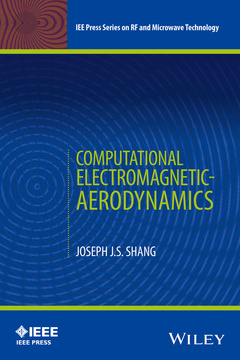Description
Computational Electromagnetic-Aerodynamics
IEEE Press Series on RF and Microwave Technology Series
Author: Shang Joseph J. S.
Language: English
Subject for Computational Electromagnetic-Aerodynamics:
448 p. · 15.5x23.6 cm · Hardback
Description
/li>Contents
/li>Biography
/li>
- Integrates interlinking computational model and simulation techniques of aerodynamics and electromagnetics
- Combines classic plasma drift-diffusion theory and electron impact ionization modeling for electromagnetic-aerodynamic interactions
- Describes models of internal degrees of freedom for vibration relaxation and electron excitations
Preface ix
1 Plasma Fundamentals 1
Introduction, 1
1.1 Electromagnetic Field, 3
1.2 Debye Length, 7
1.3 Plasma Frequency, 10
1.4 Poisson Equation of Plasmadynamics, 12
1.5 Electric Conductivity, 13
1.6 Generalized Ohm's Law, 16
1.7 Maxwell's Equations, 19
1.8 Waves in Plasma, 20
1.9 Electromagnetic Waves Propagation, 23
1.10 Joule Heating, 27
1.11 Transport Properties, 29
1.12 Ambipolar Diffusion, 32
2 Ionization Processes 36
Introduction, 36
2.1 Microscopic Description of Gas, 38
2.2 Macroscopic Description of Gas, 43
2.3 Chemical Reactions and Equilibrium, 47
2.4 Saha Equation of Ionization, 50
2.5 Ionization Mechanisms, 51
2.6 Photoionization, 54
2.7 Thermal Ionization, 56
2.8 Electron Impact Ionization, 61
3 Magnetohydrodynamics Formulation 69
Introduction, 69
3.1 Basic Assumptions of MHD, 71
3.2 Ideal MHD Equations, 74
3.3 Eigenvalues of Ideal MHD Equation, 80
3.4 Full MHD Equations, 86
3.5 Shock Jump Condition in Plasma, 91
3.6 Solutions of MHD Equations, 95
4 Computational Electromagnetics 102
Introduction, 102
4.1 Time-Dependent Maxwell Equations, 105
4.2 Characteristic-Based Formulation, 108
4.3 Governing Equations on Curvilinear Coordinates, 112
4.4 Far Field Boundary Conditions, 121
4.5 Finite-Difference Approximation, 123
4.6 Finite-Volume Approximation, 131
4.7 High-Resolution Algorithms, 137
5 Electromagnetic Wave Propagation and Scattering 146
Introduction, 146
5.1 Plane Electromagnetic Waves, 147
5.2 Motion in Waveguide, 150
5.3 Wave Passes through Plasma Sheet, 155
5.4 Pyramidal Horn Antenna, 160
5.5 Wave Reflection and Scattering, 168
5.6 Radar Signature Reduction, 177
5.7 A Prospective of CEM in the Time Domain, 180
6 Computational Fluid Dynamics 192
Introduction, 192
6.1 Governing Equations, 194
6.2 Viscous-Inviscid Interactions, 199
6.3 Self-Sustained Oscillations, 209
6.4 Vortical Dynamics, 221
6.5 Laminar-Turbulent Transition, 228
7 Computational Electromagnetic-Aerodynamics 237
Introduction, 237
7.1 Multifluid Plasma Model, 239
7.2 Governing Equations of CEA, 242
7.3 Chemical Kinetics for Thermal Ionization, 250
7.4 Chemical Kinetics for Electron Impact Ionization, 258
7.5 Transport Properties, 262
7.6 Numerical Algorithms, 268
8 Modeling Electron Impact Ionization 279
Introduction, 279
8.1 Transport Property via Drift-Diffusion Theory, 282
8.2 Drift-Diffusion Theory in Transverse Magnetic Field, 289
8.3 Boundary Conditions on Electrodes, 292
8.4 Quantum Chemical Kinetics, 300
8.5 Numerical Algorithms, 305
8.6 Innovative Numerical Procedures, 311
9 Joule-Heating Actuators 325
Introduction, 325
9.1 Features of Direct Current Discharge, 327
9.2 Virtual Leading Edge Strake, 333
9.3 Magnetic Field Amplification, 341
9.4 Virtual Variable Geometry Cowl, 349
9.5 Trailing Edge of Airfoil, 358
9.6 Hydrodynamic Stability and Self-Oscillation, 362
10 Lorentz-Force Actuator 369
Introduction, 369
10.1 Remote Energy Deposition, 371
10.2 Stagnation Point Heat Transfer Mitigation, 376
10.3 Features of Dielectric Barrier Discharge, 379
10.4 Periodic Electrostatic Force, 390
10.5 DBD Flow Control Actuator, 402
10.6 Laminar-Turbulent Transition, 406
10.7 Ion Thrusters for Space Exploration, 408
10.8 Plasma Micro Jet, 413
Index 419
Joseph Shang is a Research Professor Emeritus at Wright State University, USA, and a Scientist Emeritus at the Air Force Research Laboratory. He received his PhD in Aerospace Engineering from Ohio State University. Dr. Shang is a pioneer of Computational Fluid Dynamics (CFD) and Computational Electromagnetics (CEM), and led the development of three-dimensional, mass-averaged Navier-Stokes equations simulations for the aerodynamic performance of aerospace vehicles as well as the characteristic-based formulation for solving three-dimensional Maxwell equations in the time domain. He is a fellow of the American Institute of Aeronauts and Astronautics, and serves on the advisory board of the Aerospace Engineering Department. He has written nearly 400 articles and conference papers, as well as 14 book chapters.

